![]()
Aroids and other genera in the Collection
Take the Tour Now?
Orchids
The
Exotic Rainforest
Plants in
the Exotic Rainforest Collection
Images on this website are copyright protected. Contact us before attempting to reuse.
In depth information on how to grow Philodendron species, Click this Link
Within our collection we have many species of Philodendron.
If you are seeking other photos,
click this link
Philodendron
maximum K. Krause
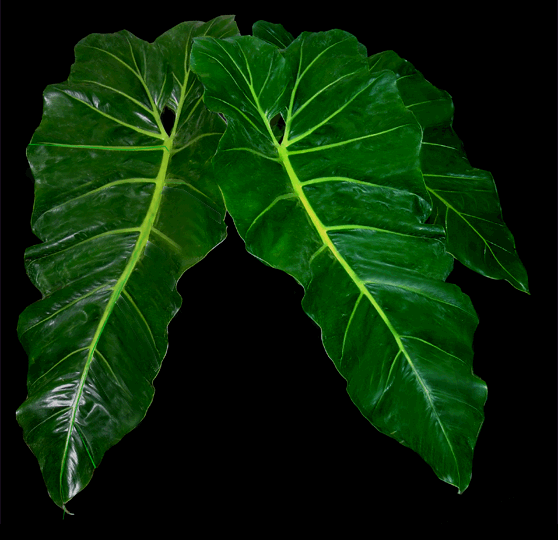
One of the world's largest Philodendron
Common name: "huembe"(Bolivia)
New information within botanical science continues to emerge regarding this species. More photos have been added to this page to show a second specimen that also closely matches the scientific description. This author is not a taxonomist and cannot comment on which plant (possibly both) is correctly Philodendron maximum. The leaf blades of the second even larger specimen seen below measure close to 2 meters (6 feet). The photo identified with Jessie Offolter and the photo with both Sam and Enid Offolter of Natural Selections Exotics are the larger "form" found in Ecuador. The leaf with Sam and Enid appears shorter due to the angle since the lens and angle can modify the appearance. The photos of Leland Miyano and of Sam Offolter are of the same "type" as seen in the top on this page.
Philodendron species are known to be variable. Not every leaf of every specimen will always appear the same. Once you read this article we suggest you also read the page linked just below explaining natural variation. Both specimens shown on this page appear to be a match to the scientific description.
Although this text contains botanical terms, every effort has been made to explain all the terms in language a collector can use and understand But the question may now be is the plant at the top of this page correctly Philodendron maximum, or is it the second specimen shown below? Could it be possible both are the same species and each is a natural variation of the same species?
Those and other questions are still being studied by botanical scientists. The following link explains in easily understood language the botany of natural variation: Click here.
Described and published scientifically in 1913,
Philodendron maximum can be found from Colombia, Ecuador, Peru, and
Brazil at elevations of 106 to 800 meters (350 to 2,625
feet) above sea level. A member of
Philodendron subsection
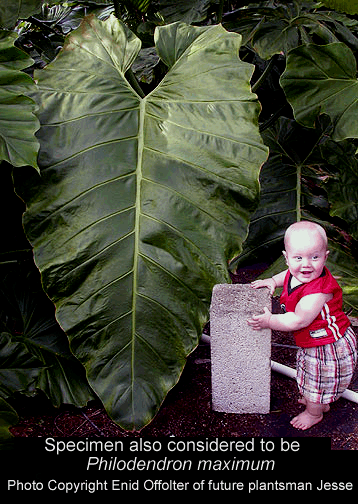 Psoropodium, this large Philodendron is found in
both tropical moist rain forests and tropical wet forest regions.
But which is the plant that correctly matches the published description by K. Krause?
The
plant at the top of the page, or the one seen to the left and below?
Psoropodium, this large Philodendron is found in
both tropical moist rain forests and tropical wet forest regions.
But which is the plant that correctly matches the published description by K. Krause?
The
plant at the top of the page, or the one seen to the left and below?
According to information furnished by aroid botanist Dr. Tom Croat of the Missouri Botanical Garden, Philodendron maximum can be found growing in old leaf bases on palms, especially Attalea phalerata known as Scheelea. Palm, aroid and cycad expert Leland Miyano explains more regarding that palm, "Attalea phalerata is a massive palm. Think of a coconut on steroids. The leaf bases are persistent for decades and great quantities of humus collects in them. Whole communities of organisms can live in this detritus and this compost is superior to the best potting soil one could . Each leaf base can collect gallons of humus and debris, so Philodendron maximum on this palm would have an excellent nutrient supply." Leland, shown in the photo to the right below, also added this additional suggestion regarding growing Philodendron maximum, "I was also keenly interested in Attalea phalerata Mart. ex. Spreng. There are several names surrounding this palm including Scheelea phalerata (Mart.) Burret, which is a synonym according to Kew. However, the most interesting observation is that this palm is abundant in dry forests and open areas, so this would give the grower of Philodendron maximum a clue as to light requirements and watering schedule." A synonym is simply an additional scientific name for the same species, often no longer in scientific use.
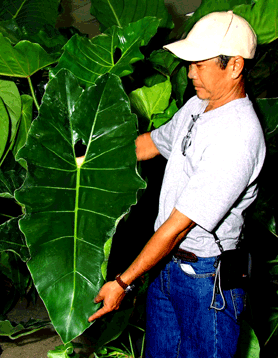 Often
stated to be one of the world's largest Philodendron species, the
type specimen of Philodendron maximum was described from
a specimen located in Brazil at Rio Paraguassu in November, 1911.
A type specimen is the original plant examined by a botanist and
determined to the any individual species.
Often
stated to be one of the world's largest Philodendron species, the
type specimen of Philodendron maximum was described from
a specimen located in Brazil at Rio Paraguassu in November, 1911.
A type specimen is the original plant examined by a botanist and
determined to the any individual species.
Philodendron maximum is known to be a plant capable of beginning life as a seed deposited by a bird on a tree limb which then sends roots to the ground or as a seed on the ground which germinates and then attaches itself to a tree and begins to climb. To a botanist, these types of plants are known as hemiepiphytes. This species is not known to climb to extreme heights and is typically seen at only 3 to 3.5 meters on the side of a host tree (approximately 10 to 11.5 feet). But what the Philodendron lacks in apparent climbing ability, it makes up for with leaf size.
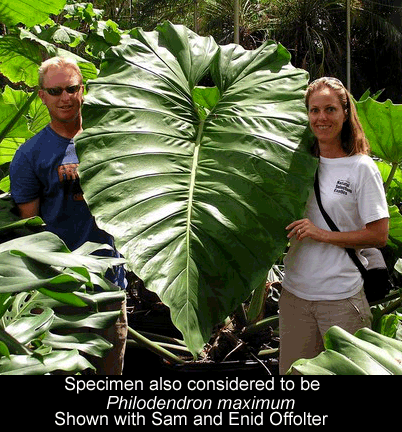 description.
As you can see in the photos, one specimen has
a much lighter green leaf blade and is also larger.
description.
As you can see in the photos, one specimen has
a much lighter green leaf blade and is also larger. The inflorescence (reproductive organ) of Philodendron maximum stands upright (erect) and a specimen is normally able to produce two complete spathes per axil. An inflorescence is composed of a spathe appearing to be a hood and spadix and is often referred to by plant collectors as a flower. In reality, the spathe is simply a modified leaf. As many as six inflorescences have been seen on mature plants in nature. The inflorescence is supported by a peduncle, the plant shaft that supports the inflorescence The peduncel can range in size from 27 to 37cm long (.9 to 1.2 feet) and 1.5 to 2cm (.6 to .78 inches) in diameter.
Our specimen (not shown) currently has leaf blades measuring approximately 60cm (2 feet) and is growing climbing a plant totem in a fast draining soil mixture of porous soil, peat, Perlite™ and orchid potting media containing bark, charcoal and gravel. The soil mixture is kept slightly moist at all times. The technical scientific information in this article was supplied by Dr. Croat. My thanks for his providing a copy of his completed treatment of Philodendron maximum which will appear in his yet unpublished journal The Flora of Ecuador.
As stated in this text there is concern among some experts as to whether
or not the specimen in the photograph at the very top of this page is the true Philodendron maximum as originally described by
Krause in 1913. Discussions among
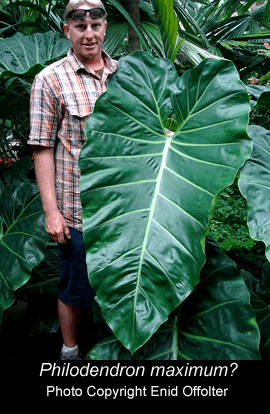 botanical experts are
certainly not
uncommon. It would appear to this untrained collector more than a single large
Philodendron species may potentially match the original description
Especially the specimens shown with future plants man
Jesse Offolter as well as the plant shown with his parents who own
Natural Selections Exotics in Fort Lauderdale, FL. That plant may
possibly be unique to Ecuador.
botanical experts are
certainly not
uncommon. It would appear to this untrained collector more than a single large
Philodendron species may potentially match the original description
Especially the specimens shown with future plants man
Jesse Offolter as well as the plant shown with his parents who own
Natural Selections Exotics in Fort Lauderdale, FL. That plant may
possibly be unique to Ecuador.
Based on email messages, botanist Dr. Tom Croat has indicated his professional opinion appears to be the specimen illustrated in my photograph at the top of this page, as well as Enid's photo to the right of this text, is the species originally described. But others have offered a different opinion. In fairness to all those who have provided information, I am including his explanation received on 12/28/07. In that message he wrote, "I just went out to see the type of P. maximum and compared it with about 25 specimens of the species that I have made or others have made in Bolivia, Brazil and Peru. It matches favorably. Then I looked at Ron's material, I have filed under Phil. Ronweeksii. It is true that there is a small difference that seems to be lacking on the other material and that is that the minor veins are more prominulous. I just don't know if that is sufficient to call it a different species. My assumption that Ron's plant was P. maximum was based on observations of the live plant at the show. Perhaps I am wrong. It would be strange if P. maximum did not occur in Ecuador since it is widespread. I even saw it in Colombia in Caqueta in April and it is exactly like the material I saw in Acre and in Bolivia. In most cases it was growing in the leaf bases of a large palm, just like I saw it in Bolivia."
Last update, July 3, 2008: Is it possible these
plants are only natural
variations of the same species? I simply don't have the expertise to offer an opinion
but only to say both are beautiful! Many thanks to all the
researchers, collectors
and growers who provided additional information as well as photos including Enid Offolter of
Natural Selections Exotics in Fort Lauderdale, FL.
Looking for a specimen? Contact
http:///
![]()
Want to learn more
about aroids?
Join the
International Aroid Society:
http://www.exoticrainforest.com/Join%20IAS.html
If you are seeking information on other rare
species, click on "Aroids and other genera in the Collection" at the top of
the page and look for
the